The Pillar coinage
by Brad Yonakafrom Brad Yonaka, A Variety Guide to the Fractional Pillar Coinage of Mexico City, 1732 - 1771, Agorocu Consulting Inc, Long Beach, California, 2017
The pillar obverse and reverse are composed of a series of separately punched design elements or devices. They range from simple to complex. Sorne of these elements were modified over the course of the series; major changes are detailed in the next section. Below is a sketch from a VF+ example, which attempts to portray a typical strike with its slight inconsistencies in detail.
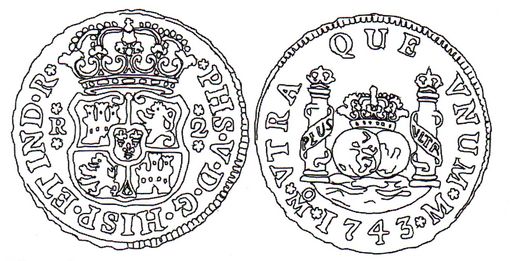 Sketch of a 1743 two reales
Sketch of a 1743 two reales
Obverse
Crown above shield
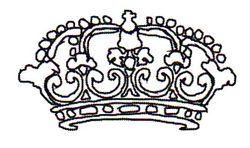 A royal crown adorns the Spanish coat of arms. It varies a bit in detail depending on denomination, with the half real showing slightly less embellishment and the four reales showing the greatest. However, the overall pattern is very consistent between denominations, and across the years. It was engraved from a single punch. One important change seen in the half, one, and two reales is that for the pre-1742 design, there was not enough space to neatly place the crown above the shield; in many examples the base of the crown overlaps the upper shield border and occasionally intrudes on the castle and lion symbols.
A royal crown adorns the Spanish coat of arms. It varies a bit in detail depending on denomination, with the half real showing slightly less embellishment and the four reales showing the greatest. However, the overall pattern is very consistent between denominations, and across the years. It was engraved from a single punch. One important change seen in the half, one, and two reales is that for the pre-1742 design, there was not enough space to neatly place the crown above the shield; in many examples the base of the crown overlaps the upper shield border and occasionally intrudes on the castle and lion symbols.
Shield
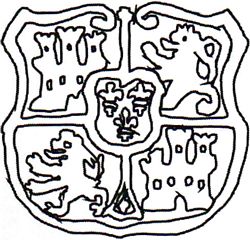 The shield portion of the coat of arms displays symbols for three of the political entities that comprised the Spanish Empire during the 1700s. They are contained within a lattice that separates the shield into six compartments. Unlike the crown, the shield was generated from at least five different punches; (1) the upper left castle, (2) the lower right castle, (3) the upper right lion, ( 4) the lower left lion, and (5) the surrounding lattice. It appears that the Fleur-de-lis symbols (center) and pomegranate (bottom center) were part of the lattice punch.
The shield portion of the coat of arms displays symbols for three of the political entities that comprised the Spanish Empire during the 1700s. They are contained within a lattice that separates the shield into six compartments. Unlike the crown, the shield was generated from at least five different punches; (1) the upper left castle, (2) the lower right castle, (3) the upper right lion, ( 4) the lower left lion, and (5) the surrounding lattice. It appears that the Fleur-de-lis symbols (center) and pomegranate (bottom center) were part of the lattice punch.
The upper left and lower right compartments are occupied by castles, symbolic of the Kingdom of Castile. The upper right and lower left compartments are occupied by lions rampant, symbolic of the Kingdom of León. This arrangement of symbols on the coat of arms was established in 1230 AD when the two lands were united (for the last time) by Ferdinand III. Separated from the rest of the design, the castles and lions rampant appear as follows:
Neither castle is a full image (except in the special case of some half reales). The upper left is missing a significant portion of the base, while the lower right has a truncated left tower, This was done to more easily fit the symbols within the relevant compartments.
The lower left lion is almost always complete, sometimes with an abbreviated tail. The upper right lion almost always misses two of the four paws, which were part of the punch but are commonly covered by the border lattice. On occasion a paw can be seen intruding the central compartment that the Fleur-de-lis occupies. The most complete lions can be observed on the four reales, where large coin size allowed a more relaxed use of space.
The center of the coat of arms displays three Fleur-de-lis, symbolizing the French House of Bourbon, initially in the person of Philip, Duke of Anjou. He was the successful claimant to the Spanish throne in 1700, where he was crowned King Philip V. The House of Bourbon would rule Spain during the entirety of the pillar series. The three Fleur-de-lis were struck together on one punch, and there are always slight shape differences between each symbol. The detail on the symbols becomes more easily discerned on the larger denominations. The following photo set shows the increasing detail visible from a half real (left) to a four reales (right):

The placement of the Fleur-de-lis opposite the high relief globes sometimes did not allow for the former to be fully struck up. This phenomenon is most notable in the one real denomination.
Ali denominations except the half real show Fleur-de-lis designs that do not vary over the forty years of issue. In the latter case, there are several changes in both the Fleur-de-lis and intrusion of castles into the central compartment. These changes were not used to differentiate varieties, since they are relatively minor and are not always possible to view. The following figures illustrate the modifications and their timeframes.
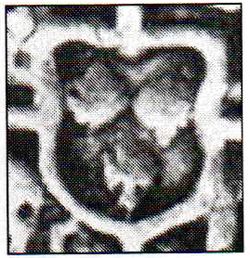 This example from 1733 shows the most detail-rich version of the Fleur-de-lis symbols. This design was used from 1732 until 1757.
This example from 1733 shows the most detail-rich version of the Fleur-de-lis symbols. This design was used from 1732 until 1757.
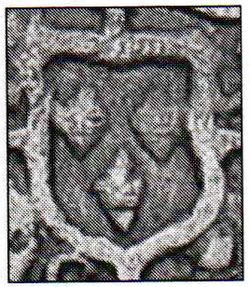 This example from 1733 shows the 'simple' Fleur-de-lis style, in which the shapes are somewhat like diamonds. This type was used concurrently with the previous 'detailed' style until about 1736, at which point it appears less commonly until 1757.
This example from 1733 shows the 'simple' Fleur-de-lis style, in which the shapes are somewhat like diamonds. This type was used concurrently with the previous 'detailed' style until about 1736, at which point it appears less commonly until 1757.
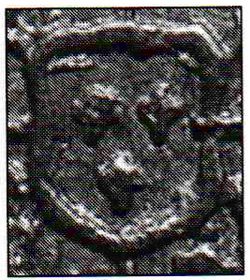 In 1757, at the same time the left pillar crown changes from royal to imperial, the Fleur-de-lis begin to give the appearance of crude crnsses. The example shown is from 1763. Also, the castle punches used in the outer compartments were not truncated. Note the foot of the upper left castle and tower of the lower right castle intrude the central compartment. This is a characteristic of issues between 1757 and 1763.
In 1757, at the same time the left pillar crown changes from royal to imperial, the Fleur-de-lis begin to give the appearance of crude crnsses. The example shown is from 1763. Also, the castle punches used in the outer compartments were not truncated. Note the foot of the upper left castle and tower of the lower right castle intrude the central compartment. This is a characteristic of issues between 1757 and 1763.
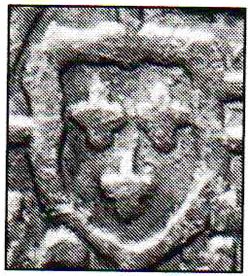 In 1764, the castle punches were again truncated and do not intrude into the central compartment. The example shown is from 1765. The cross-like Fleur-de-lis symbols continue to the end of the series.
In 1764, the castle punches were again truncated and do not intrude into the central compartment. The example shown is from 1765. The cross-like Fleur-de-lis symbols continue to the end of the series.
The tear-shaped compartment at bottom center of the shield houses the image of a pomegranate, symbol of Granada. This city and surrounding territory was won by the Spanish Christians in 1492 after a long war with the Arab Emirate that had held it for centuries. Due to the small size of the symbol, it is usually little more than a roundish blob on denominations less than four reales.
Legend
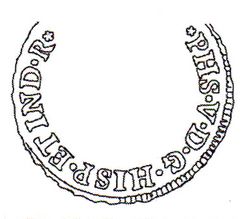 The obverse legend (for half, one, and two reales after 17 41) reads PHS V ( or FRD VI or CAR 111) D G HISP ET IND R, which is an abbreviation for PHILIPUS V (or FERDINANDUS VI or CAROLUS III) DEI GRATIA HISPANIARUM ET INDIARUM REX. This translates as: '[king's name], by the grace of God, King of the SpainsLiterally 'Spains' in the sense that Spain itself is a union of Iberian territories with very different cultures and history. and the Indies'. On half, one, and two reales 1741 and earlier, as well as four reales of all dates, the legend is slightly expanded to read PHILIP V ( or FERDND VI or CAROLVS 111) D G HISPAN ET IND REX. It also makes an unbroken circle around the periphery of the coin.
The obverse legend (for half, one, and two reales after 17 41) reads PHS V ( or FRD VI or CAR 111) D G HISP ET IND R, which is an abbreviation for PHILIPUS V (or FERDINANDUS VI or CAROLUS III) DEI GRATIA HISPANIARUM ET INDIARUM REX. This translates as: '[king's name], by the grace of God, King of the SpainsLiterally 'Spains' in the sense that Spain itself is a union of Iberian territories with very different cultures and history. and the Indies'. On half, one, and two reales 1741 and earlier, as well as four reales of all dates, the legend is slightly expanded to read PHILIP V ( or FERDND VI or CAROLVS 111) D G HISPAN ET IND REX. It also makes an unbroken circle around the periphery of the coin.
Information to the left and right of shield
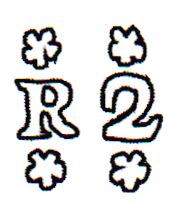 To the left of the shield is the letter R for ‘reales’ on all half, one and two reales after 1741. This space contains the assayers’ initials in those denominations 1741 and earlier, as well as four reales of all dates. To the right of the shield is the denomination, for all dates of all denominations, except in the case of the half real, which displays only a plain cross.
To the left of the shield is the letter R for ‘reales’ on all half, one and two reales after 1741. This space contains the assayers’ initials in those denominations 1741 and earlier, as well as four reales of all dates. To the right of the shield is the denomination, for all dates of all denominations, except in the case of the half real, which displays only a plain cross.
Reverse
Globes and seas
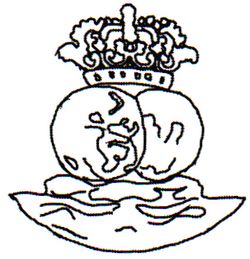 The center of the reverse displays two hemispheres topped by a royal Spanish crown and washed by an ocean. It is meant to symbolize the New World (left) and Old World (right), both under the dominance of the Spanish king. The geographic details of the globes is visible only in higher grade specimens, and is also more easily viewed in coins from the early 1760s onwards due to augmentation of the design on one, two and four reales.
The center of the reverse displays two hemispheres topped by a royal Spanish crown and washed by an ocean. It is meant to symbolize the New World (left) and Old World (right), both under the dominance of the Spanish king. The geographic details of the globes is visible only in higher grade specimens, and is also more easily viewed in coins from the early 1760s onwards due to augmentation of the design on one, two and four reales.
Pillars
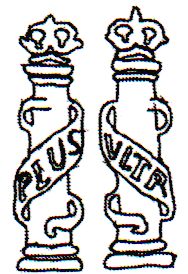 The pillars bracketing the above globes symbolize the Pillars of Hercules, mythical structures built by Hercules on either sides of the Straits of Gibraltar to mark the edge of the known world. Passing through this ‘gate’ from east to west was the equivalent of passing into the unknown. Each pillar is topped by the Spanish royal crownThe royal crown on the left pillar is replaced by an imperial crown in the 1750s. This transition is discussed in the following section on basic design changes., and wrapped with banners proclaiming ‘PLUS ULTR[A]’ meaning ‘further beyond’. It is an exhortation to Spanish explorers to continue searching out new lands across the ocean. Only the two and four reales exhibit the lettering on the example sketch; for lack of space the one real has 'PLU VLT' and the half real has 'PL VL'.
The pillars bracketing the above globes symbolize the Pillars of Hercules, mythical structures built by Hercules on either sides of the Straits of Gibraltar to mark the edge of the known world. Passing through this ‘gate’ from east to west was the equivalent of passing into the unknown. Each pillar is topped by the Spanish royal crownThe royal crown on the left pillar is replaced by an imperial crown in the 1750s. This transition is discussed in the following section on basic design changes., and wrapped with banners proclaiming ‘PLUS ULTR[A]’ meaning ‘further beyond’. It is an exhortation to Spanish explorers to continue searching out new lands across the ocean. Only the two and four reales exhibit the lettering on the example sketch; for lack of space the one real has 'PLU VLT' and the half real has 'PL VL'.
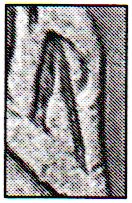 On the four reales, the 'R' appears to have been made from an inverted V with a separately made weak upper loop, as shown in the example to the left. No other denomination shows this characteristic.
On the four reales, the 'R' appears to have been made from an inverted V with a separately made weak upper loop, as shown in the example to the left. No other denomination shows this characteristic.
Legend
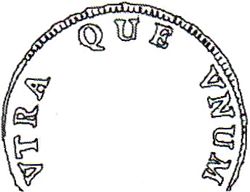 The reverse Latín legend reads VTRA QUE VNUM for ali dates and denominations, though in some cases the words are not well separated. Translates as 'that the two may be one' meaning the Spanish brought the New and Old Worlds together.
The reverse Latín legend reads VTRA QUE VNUM for ali dates and denominations, though in some cases the words are not well separated. Translates as 'that the two may be one' meaning the Spanish brought the New and Old Worlds together.
Date, mintmark, mintmark / assayer’s initial
 Below the reverse legend, centered at 6 o’clock, is the date. To the left is always the mintmark of Mexico City, the letter M with an 'o' above, except for some varieties in 1733 which use the letters MX. To the right is the chief assayer initcial on all half, one, and two reales starting in 1742. Prior to 1742 this position is occupied by a repeat of the mintmark on half, one, and two reales. The four reales shows the mintmark on both sides for all dates.
Below the reverse legend, centered at 6 o’clock, is the date. To the left is always the mintmark of Mexico City, the letter M with an 'o' above, except for some varieties in 1733 which use the letters MX. To the right is the chief assayer initcial on all half, one, and two reales starting in 1742. Prior to 1742 this position is occupied by a repeat of the mintmark on half, one, and two reales. The four reales shows the mintmark on both sides for all dates.
Background of the Basic Design Changes
This section details the major design changes exhibited by the coins in this series, many of which are mentioned briefly in the previous section on design elements. They are modifications executed through authorized channels, and constitute the basic phases of the series.
King's name
Changes in king (name of king is shown exactly as it appears in the legend):
| King | Philip V | Ferdinand VI | Charles III | |
| Coin date | 1732-1741 | 1742-1747 | 1747-1760 | 1760-1771 |
| ½ real | PHILIP V | PHS V | FRD VI | CAR III |
| 1 real | PHILIP V | PHS V | FRD VI | CAR III |
| 2 reales | PHILIP V | PHS V | FRD VI | CAR III |
| 4 reales | PHILIP V | FRD VI | CAR III | |
| 8 reales | ||||
Kings' names as shown on coins for each denomination.
Changes in the king's name in both cases (1747 and 1760) occur the year after the ruler died and a new king was installed on the throne. In addition, the switch on the coins only occurred part way through the year, thus generating two varieties in each case. The change in lettering during the reign of Philip V executed in 1742 on half, one, and two reales is discussed below.
Assayers’ initials
The chief and assistant chief assayer ( essentially a 'weigher of silver') were held accountable for the correct silver content of each coin leaving the mint. Hence their initials were required on the coins as proof that their quality inspection had taken place. Changes in assayers' initials, following changes in mint management, are also a substantive design alteration, summarized in the following table:
| 1732 | 1732-1733 | 1733-1741 | 1742-1753 | 1754-1764 | 1765-1770 | 1770-1771 | |
| ½ real | - | F | MF | M | M | F | |
| 1 real | - | F | MF | M | M | F | |
| 2 reales | - | F | MF | M | M | F | |
| 4 reales | - | F | MF | MM | MF | MF | |
| 8 reales | |||||||
Assayers' initials as shown on coins far each denomination.
The above intervals reflect changes in the responsible personnel, except for 1741-1742, which is discussed below. Note that there are several years where there is overlap of assayer initial configurations. Though only two initials appear during the entire span of issue, they refer to five different people, as detailed here.
Changes in layout from 1742
In 1742, the half, one, and two reales were redesigned. On the obverse, several words in the legend were shortened and the coat of arms was shifted upwards vertically, close to the rim. The assayers' initials, which were left of the coat of arms, were moved to the right of the date on the reverse side, and the letter 'R' for 'reales' was inserted in its place. Previously, a second mintmark had occupied the space to the right of the date, perhaps to give the reverse legend symmetry.
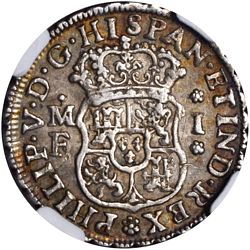
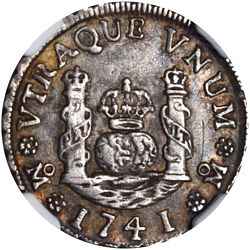
Old design obverse legend: [KING] D.G.HISPAN.ET IND.REX
1742 1r (Stack’s Bowers Auction 25 February 2021, lot 74040)
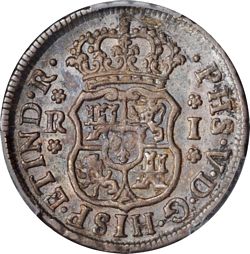
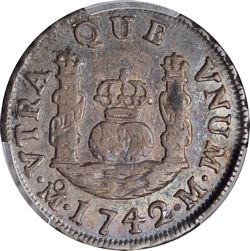
New design obverse legend: [KING] D.G.HISP.ET IND.R
1741 1r (Stack’s Bowers NYINC Auction 16 January 2018, lot 24325)
Change from royal to imperial crown
In 1757 – 1758 for the half, one, and two reales, and in 1754 for the four reales, the left pillar crown on the reverse was changed from the royal (same as that on top of the right pillar) to an imperial crown. There are several years in each denomination where the two design types overlap, and in the case of half and four reales, the imperial crown itself was modified in later years.
